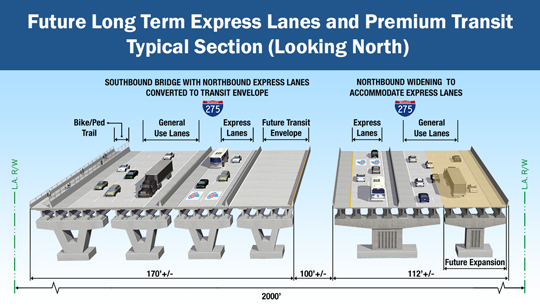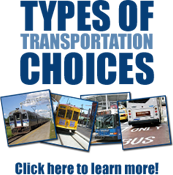Study Goals & Objectives
The following goals and objectives have been defined for this overall Study:
- Undertake the necessary PD&E Study evaluation and documentation efforts needed to secure federal approval for the planned replacement of the northbound Howard Frankland Bridge structure. The Study’s outcome must accommodate the transit provision identified in the preliminary Locally Preferred Alternative.
- Complete the corridor evaluation and alternatives analysis work culminating
in the identification and approval of a preliminary Locally Preferred
Alternative (LPA).
- Identify any subsequent efforts that will be required to satisfy the NEPA
and other various federal environmental evaluation and documentation requirements needed to implement the preliminary Locally
Preferred Alternative.
- Prepare a New Starts report to be submitted to FTA for project evaluation and rating. (Optional, required only if the Study evolves into a formal New Starts Alternatives Analysis.)
- Identification of concerned public
Transit Evaluation Goals & Objectives
Goal 1: Maximize Regional Connectivity - Establish a feasible transit connection between Pinellas and Hillsborough Counties
| Objectives: | |
|
|
Goal 2: Maximize Future Transportation Facility Benefits
| Objectives: | |
|
|
Goal 3: Minimize Adverse Environmental & Community Impacts
| Objectives: | |
|
|
Goal 4: Maximize Engineering Feasibility and Public Safety
| Objectives: | |
|
|
Goal 5: Maximize Transit Service Efficiency and Integration
| Objectives: | |
|
|
Goal 6: Maximize Financial Feasibility
| Objectives: | |
|
|
Howard Frankland Bridge Proposed Improvements
The Recommended Alternative consists of replacing the existing northbound bridge with a wider four-lane bridge (4 southbound general use lanes, plus 2 tolled express lanes in each direction) that will be constructed to the west of the existing bridges, as shown below. This proposed alignment will have minimal impact to seagrass and other environmental resources. Construction of the new bridge will not impact existing traffic flow.
The new bridge will be constructed approximately 8 feet higher than the existing southbound bridge. This will minimize the chance of damage from waves during an extreme weather event. The proposed new bridge will include a 12-foot shared use path ("bike-ped trail") on the west side of the bridge.
Once the new bridge is constructed, the older existing northbound structure will be removed. The estimated cost of the improvements, including the roadway transitions at either end of the bridge, is approximately $785 million in 2017 dollars.
The typical sections for the proposed improvements are shown below:

Transit Accommodations
In addition to the bridge replacement, a separate but related study is ongoing to evaluate the feasibility of including accommodations for premium transit services within the Howard Frankland Bridge corridor. The Department, in coordination with its agency partners on both sides of the Bay, is working to set aside space for a transit connection across the Howard Frankland Bridge that will link Pinellas and Hillsborough Counties via transit stations. Structural enhancements will need to be made in order to carry loading for future transit vehicles, which will cost approximately $25 million.

Other Bridge Replacement Alternatives Considered
2013 Recommended Build Alternative
During the study, anticipated growth and future transportation needs were analyzed. This evaluation led to the development of several previously proposed alternatives.
The alternative presented in 2013 included building a new bridge between the existing bridges, and removing the older northbound structure. That new bridge would then carry northbound traffic.
After that public hearing the FDOT reevaluated the construction issues related to building in the center of the two existing bridges and began to look at adding express lanes as well.
2016 Recommended Build Alternative
This led to proposing a recommended alternative for the new bridge to be on the west side of the southbound bridge. In addition, the alternative included the adding one express lane in each direction. This alternative was made available to the public in 2016. Just prior to the public hearing based on public input the FDOT decided to reevaluate this option.
Initial Transit Alternatives Concepts
All initial transit Build Alternatives concepts include connection to the Westshore Regional Multimodal Center in Hillsborough and the proposed transit station in Pinellas County (Pinellas Alternatives Analysis Study). The alternatives to connect to the Pinellas County station are named with a “P” and alternatives to connect to the Hillsborough County Westshore Regional Multimodal Center are named with a “H”. The overall alternative between Pinellas and Hillsborough will be a combination of a Pinellas “P” alternative and a Hillsborough “H” alternative. The number that follows the county designator in the alternative number relates to the option for transit to cross Old Tampa Bay in the HFB corridor. The letter and sub-letters (i.e., I, ii, iii, etc.) following that HFB option number relates to the route leading from the HFB corridor to the potential station. Below is an alternative numbering key and the draft initial transit alternatives concepts under review for the study.
Alternative Numbering Key
Highlighted items below are still under consideration based on bridge replacement alternative.
Howard Frankland Bridge corridor transit locations:
- 1: West (North) Side (Pinellas)
- 2: East (South) Side
- 3: Outside/Bifurcated lanes
- 4: Inside/Center lanes (Hillsborough and Bay Crossing)
- 5: Stacked – Transit guideway over I-275 Mainline
- 6: Stacked – Transit guideway under I-275 Mainline
P: Pinellas County Alternatives – Gateway Station Connection:
- A: Ulmerton Road exit
- B: Roosevelt Boulevard exit
- "i" are other options of that alternative
H: Hillsborough County Alternatives – Westshore Regional Multimodal
Center Station Connection:
- A: Kennedy Boulevard exit
- B: Reo Street/Cypress Street exit
- C: I-275 Center Lane exit at Westshore station platform
- "i" are other options of that alternative






